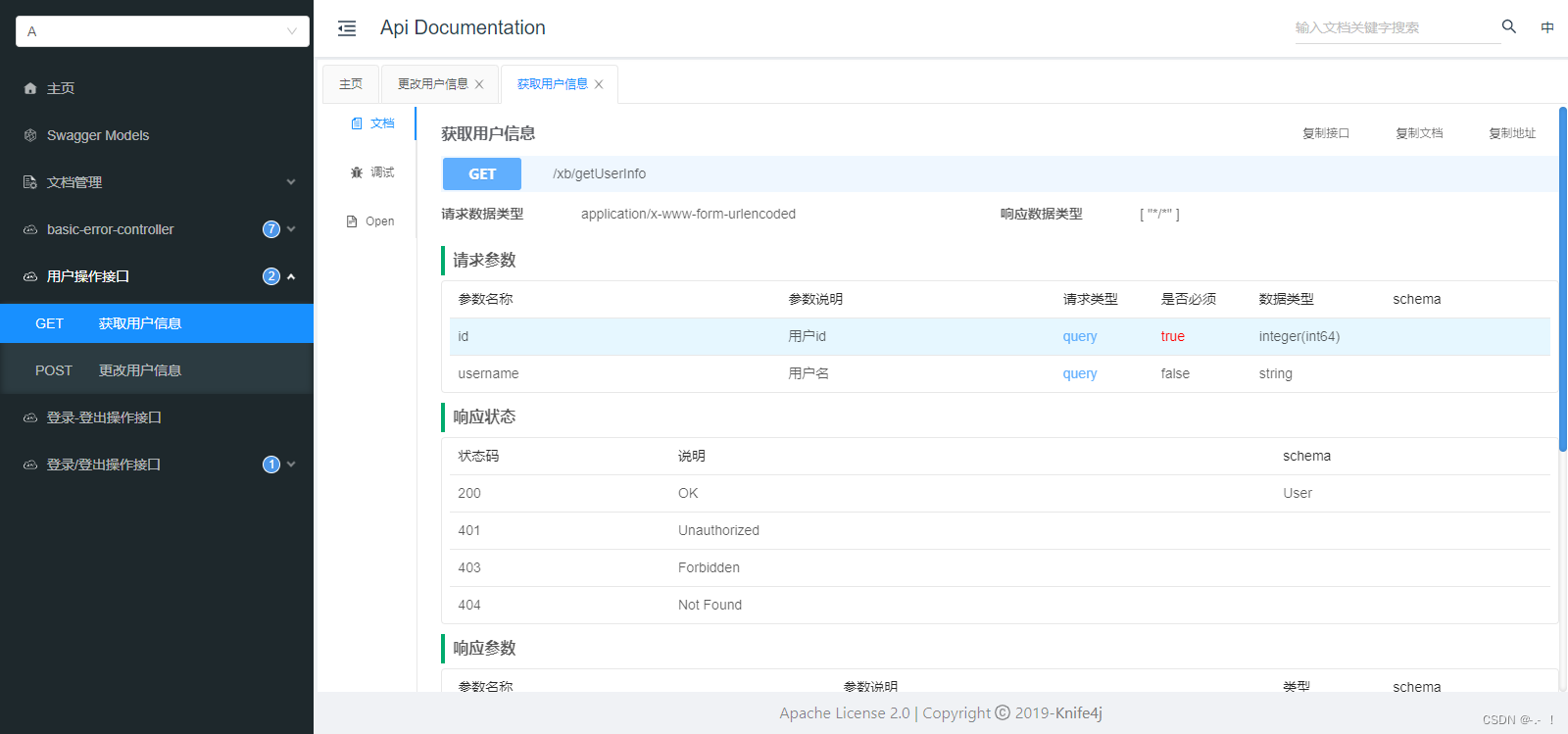文章目录
前言
后端开发,提供 Restful 接口给前端,Swagger3 提供 Restful 的接口文档自动生成和在线接口调试。Knife4j 是对 Swagger 进一步封装,优化了 API 文档的 UI 界面。
一、Pom 导入 Knife4j 依赖
<dependency>
<groupId>com.github.xiaoymin</groupId>
<artifactId>knife4j-spring-boot-starter</artifactId>
<version>3.0.3</version>
</dependency>
二、修改 application.yaml 配置文件
# knife4j配置
knife4j:
# 启用
enable: true
# 增强配置
setting:
enableSwaggerModels: true
enableDocumentManage: true
enableHost: false
enableHostText: http://localhost
enableRequestCache: true
enableFilterMultipartApis: false
enableFilterMultipartApiMethodType: POST
language: zh-CN
# 开启屏蔽文档资源
production: true
三、创建一个 Knife4jConfig 类
@Configuration
@EnableKnife4j
public class Knife4jConfig {
@Bean
public Docket docket1() {
return new Docket(DocumentationType.SWAGGER_2).groupName("A");
}
@Bean
public Docket docket2() {
return new Docket(DocumentationType.SWAGGER_2).groupName("B");
}
@Bean
public Docket docket3() {
return new Docket(DocumentationType.SWAGGER_2).groupName("C");
}
@Bean
public Docket docket(Environment environment) {
// 设置要显示swagger环境
Profiles profiles = Profiles.of("dev", "test");
// 判断是否处在在自己设定的环境当中
boolean flag = environment.acceptsProfiles(profiles);
return new Docket(DocumentationType.SWAGGER_2)
.apiInfo(apiInfo())
// 是否启动swagger
.enable(flag)
// 分组名称
.groupName("雪山")
// 设置哪些接口暴露给Swagger展示
.select()
/**
* 配置要扫描的接口的方式 RequestHandlerSelectors
* basePackage:指定要扫描的包
* any(): 扫描全部
* none():不扫描
* withClassAnnotation(RestController.class): 扫描类上有RestController.class的注解
* withMethodAnnotation(GetMapping.class): 扫描方法上的注解
*/
// 扫描所有有注解的api,用这种方式更灵活
.apis(RequestHandlerSelectors.withMethodAnnotation(ApiOperation.class))
// 指定Controller扫描包路径
// .apis(RequestHandlerSelectors.basePackage("com.xb.controller"))
// 过滤请求路径
.paths(PathSelectors.ant("/xb/**"))
.build();
}
private ApiInfo apiInfo() {
// 作者信息
Contact contact = new Contact("哈哈哈", "https://blog.csdn.net/xx", "xx@qq.com");
return new ApiInfo(
"SwaggerAPI文档",
"远航",
"v1.0",
"https://github.com/xx",
contact,
"Apache 2.0",
"http://www.apache.org/licenses/LICENSE-2.0",
new ArrayList<>()
);
}
}
四、Api 注解的使用
1、控制类
@Api(value = "用户controller", tags = {"用户操作接口"})
@RestController
public class UserController {
@ApiOperation(value = "获取用户信息")
@GetMapping("/xb/getUserInfo")
public User getUserInfo(@ApiParam(name = "id", value = "用户id", required = true) Long id, @ApiParam(name = "username", value = "用户名") String username) {
return new User();
}
@ApiOperation("更改用户信息")
@PostMapping("/xb/updateUserInfo")
public int updateUserInfo(@RequestBody @ApiParam(name = "用户对象", value = "传入json格式", required = true) User user) {
return 999;
}
}
2、实体类
@Data
@AllArgsConstructor
@NoArgsConstructor
@ApiModel(value = "", description = "用户对象user")
public class User implements Serializable {
private static final long serialVersionUID = 1L;
@ApiModelProperty(value = "用户名", example = "xx")
private String username;
@ApiModelProperty(value = "状态", required = true)
private Integer state;
private String password;
private String nickName;
private Integer isDeleted;
@ApiModelProperty(value = "id数组", hidden = true)
private String[] ids;
private List<String> idList;
}
五、启动测试访问
启动项目,在浏览器输入 http://localhost:8080/doc.html 就可以看到接口的信息。
























 4090
4090











 被折叠的 条评论
为什么被折叠?
被折叠的 条评论
为什么被折叠?










